Excavation Contractors Felixstowe
Find Excavating Contractors in Felixstowe
Get up to 3 Excavation Contractor quotes for your project today! Compare profiles, reviews, accreditations, portfolio, etc... and choose the best deal.
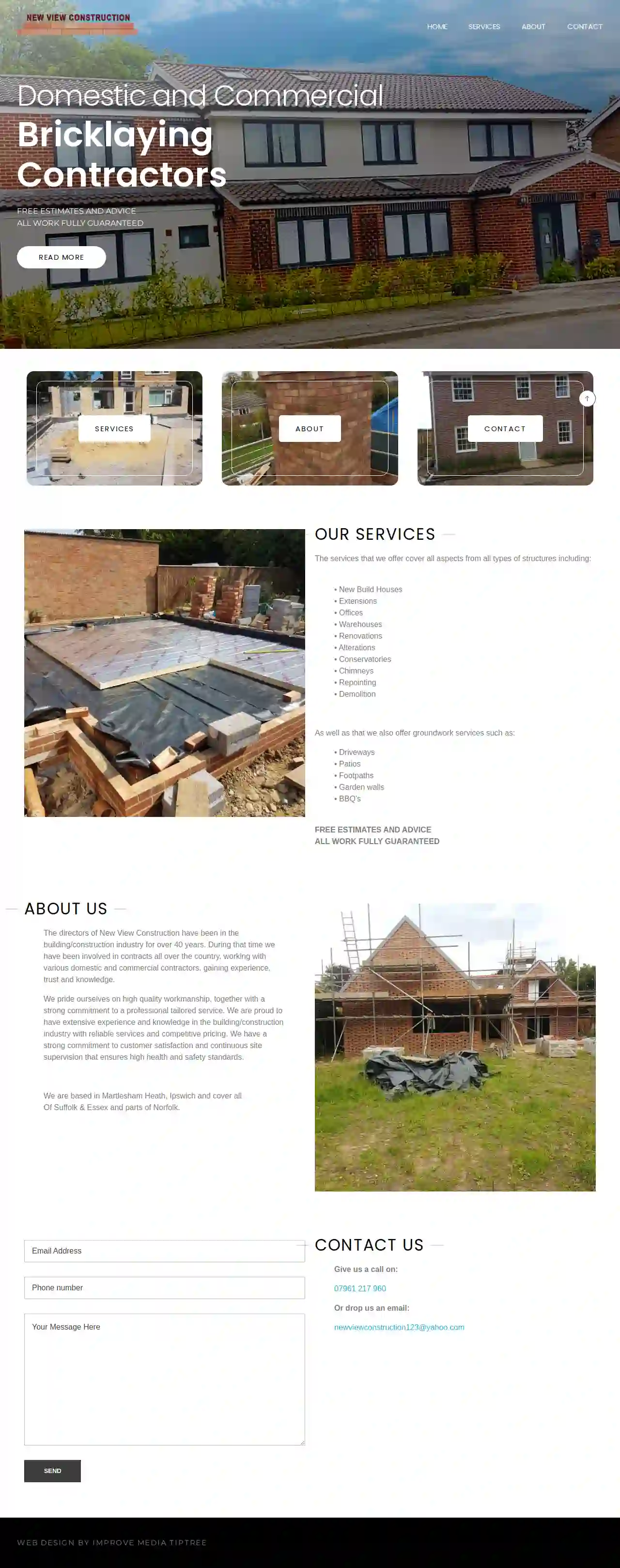
New View Construction
55 reviewsMartlesham Heath, GBAbout New View Construction The directors of New View Construction have been in the building/construction industry for over 40 years. During that time we have been involved in contracts all over the country, working with various domestic and commercial contractors, gaining experience, trust and knowledge. We pride ourselves on high quality workmanship, together with a strong commitment to a professional tailored service. We are proud to have extensive experience and knowledge in the building/construction industry with reliable services and competitive pricing. We have a strong commitment to customer satisfaction and continuous site supervision that ensures high health and safety standards. We are based in Martlesham Heath, Ipswich and cover all of Suffolk & Essex and parts of Norfolk.
- Services
- Why Us?
- Gallery
Get Quote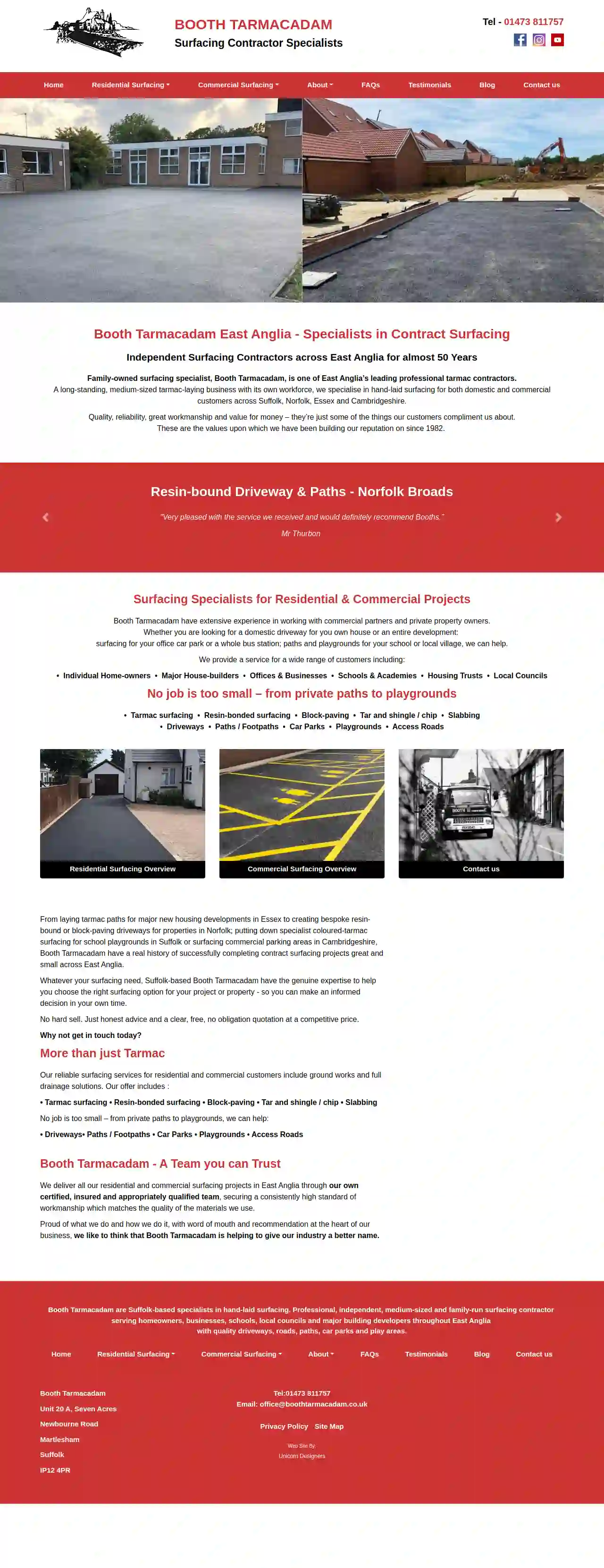
Booth Tarmacadam
4.73 reviewsUnit 20A, Seven Acres Business Park, Unit 20A Seven Acres Business Park Newbourne Rd Woodbridge Suffolk, Woodbridge, IP12 4PT, GBBooth Tarmacadam East Anglia - Specialists in Contract Surfacing Independent Surfacing Contractors across East Anglia for almost 50 Years Family-owned surfacing specialist, Booth Tarmacadam, is one of East Anglia’s leading professional tarmac contractors. A long-standing, medium-sized tarmac-laying business with its own workforce, we specialise in hand-laid surfacing for both domestic and commercial customers across Suffolk, Norfolk, Essex and Cambridgeshire. Quality, reliability, great workmanship and value for money – they’re just some of the things our customers compliment us about. These are the values upon which we have been building our reputation on since 1982. Surfacing Specialists for Residential & Commercial Projects Booth Tarmacadam have extensive experience in working with commercial partners and private property owners. Whether you are looking for a domestic driveway for you own house or an entire development: surfacing for your office car park or a whole bus station; paths and playgrounds for your school or local village, we can help. We provide a service for a wide range of customers including: Individual Home-owners Major House-builders Offices & Businesses Schools & Academies Housing Trusts Local Councils No job is too small – from private paths to playgrounds Tarmac surfacing Resin-bonded surfacing Block-paving Tar and shingle / chip Slabbing Driveways Paths / Footpaths Car Parks Playgrounds Access Roads Booth Tarmacadam Ltd From laying tarmac paths for major new housing developments in Essex to creating bespoke resin-bound or block-paving driveways for properties in Norfolk; putting down specialist coloured-tarmac surfacing for school playgrounds in Suffolk or surfacing commercial parking areas in Cambridgeshire, Booth Tarmacadam have a real history of successfully completing contract surfacing projects great and small across East Anglia. Whatever your surfacing need, Suffolk-based Booth Tarmacadam have the genuine expertise to help you choose the right surfacing option for your project or property - so you can make an informed decision in your own time. No hard sell. Just honest advice and a clear, free, no obligation quotation at a competitive price. Why not get in touch today?
- Services
- Why Us?
- Testimonials
- Gallery
Get Quote
WJS Contracting
4.574 reviewsIpswich, GBTake your yard to the next level Order a Firewood Delivery Today! QUALITY & PROFESSIONALISM WITH A SMILE More than just a contracting company Our goal at WJS Contracting is to handle all of your outdoor services with professionalism, quick communication, and a smile on our face. Headquartered just north of Boston MA, we bring the team and the lineup of heavy equipment to handle any size outdoor project. PROUD TO BE THE ONLY BOXWEDGE FIREWOOD PROVIDER IN MASSACHUSETTS Firewood delivered straight to your door As one of the largest firewood providers in New England, we offer a variety of firewood, including: green hardwood, semi seasoned hardwood, and seasoned hardwood. All delivered to you. WJS Contracting is the only company in Massachusetts with box wedge firewood!
- Services
- Why Us?
- Gallery
Get Quote
Landmark Construction Services Ltd
2.77 reviews11 Bullen Ln, Bramford, Ipswich, IP8 4JD, GBLandmark Construction We undertake contracts from both the private and commercial sectors, covering a wide range of different size projects, from small home and garden improvements, through to large housing and industrial estate developments. The Family owned and run business specialises in groundwork, civil engineering and new build projects for a variety of industrial and domestic clients. We pride ourselves on providing an efficient, flexible, reliable and competent service at all times. AN EXPERIENCED AND SKILLED TEAM The company is staffed by an experienced and skilled team, equipped to undertake a variety of projects irrespective of size and complexity. This also ensures that all work is tailored to meet the clients needs. A THOROUGH, HIGH STANDARD OF WORK The area of construction in which we operate is extremely competitive and it can be very difficult for anyone to consider using a new supplier. However, we can assure you that our staff consistently seek to provide a thorough, high standard of work and a level of service and reliability that ensures our customers are happy to return to us for their future requirements.
- Services
- Why Us?
- Our Team
- Gallery
Get Quote
Tarnowski Construction
Rowley, GBAbout Us Tarnowski Construction is New England’s go-to construction service business. Whether you’re looking for sitework, demolition, excavation, snow removal or trucking, Tarnowski Construction is here to help you with your next project! Quality Quality of work at Tarnowski Construction is key to getting the job done. We value our clients commitment to trusting us! Safety Safety is our top priority. It is essential that on every job site, we abide by all laws and regulations and operate in a safe way. Growth We want to ensure that working with Tarnowski is beneficial for the client first. Life is about moving forward and we'd love to help! Equipment Tarnowski Construction ensures that we have the capability to get the job done. No project will ever be left stranded.
- Services
- Why Us?
- Gallery
Get Quote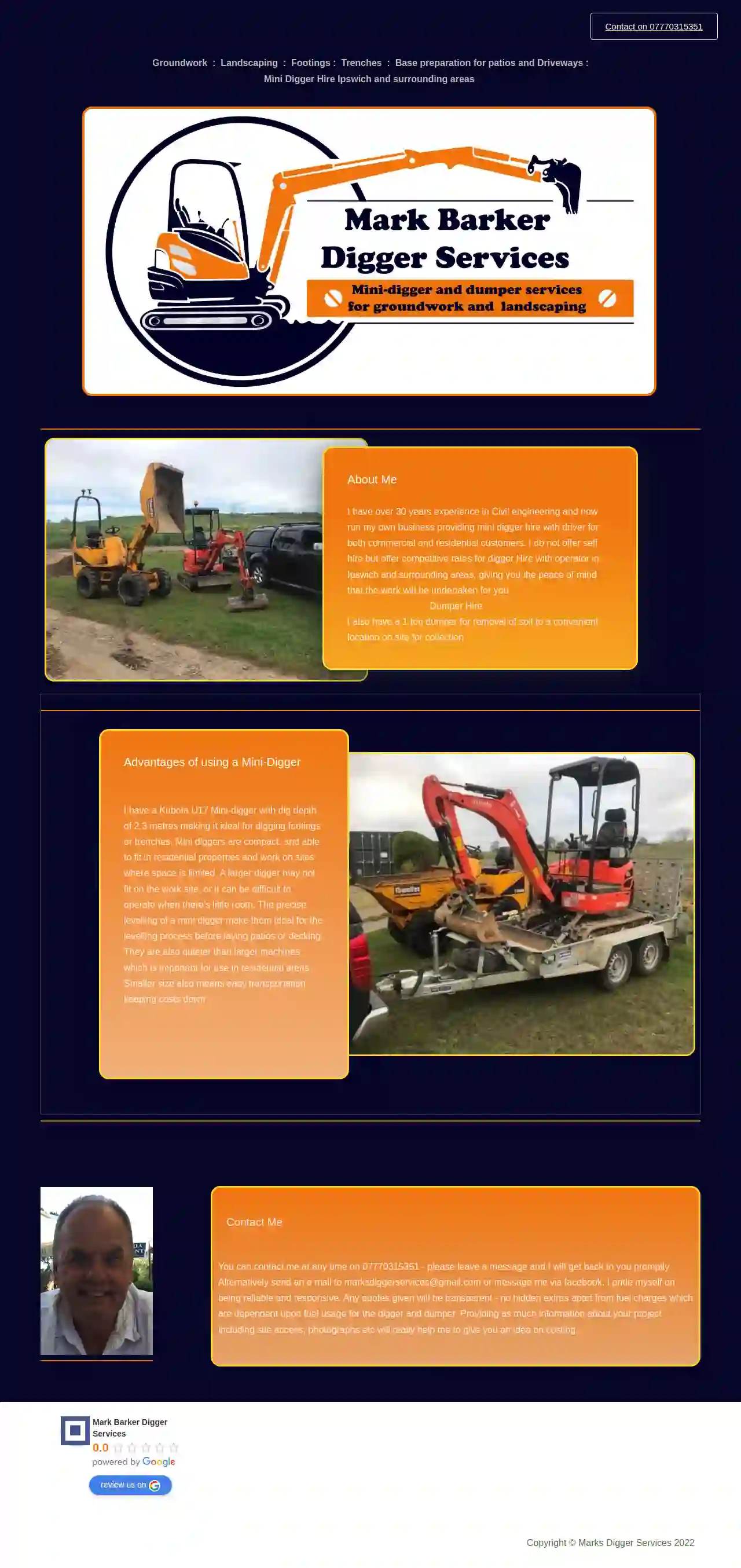
Mark Barker Digger Services
548 reviewsIpswich, GBAbout Mark Barker Digger Services Mark Barker Digger Services is a trusted and experienced provider of mini digger hire with a driver for both commercial and residential customers in Ipswich and surrounding areas. With over 30 years of experience in civil engineering, Mark offers competitive rates and reliable service, ensuring your project is completed to the highest standards. Mark's expertise extends beyond mini digger hire. He also provides a 1-ton dumper for soil removal, making it a one-stop shop for your excavation needs. Mark's mini digger is a Kubota U17, boasting a dig depth of 2.3 meters, making it ideal for digging footings or trenches. Its compact size allows it to access tight spaces in residential properties, where larger diggers may struggle. The mini digger's precision leveling capabilities make it perfect for preparing the ground for patios or decking. Mark prides himself on transparency and reliability. Quotes are provided with no hidden extras, except for fuel charges, which are calculated based on usage. To ensure accurate costing, Mark encourages customers to provide as much information as possible about their project, including site access and photographs.
- Services
- Why Us?
- Our Team
- Gallery
Get Quote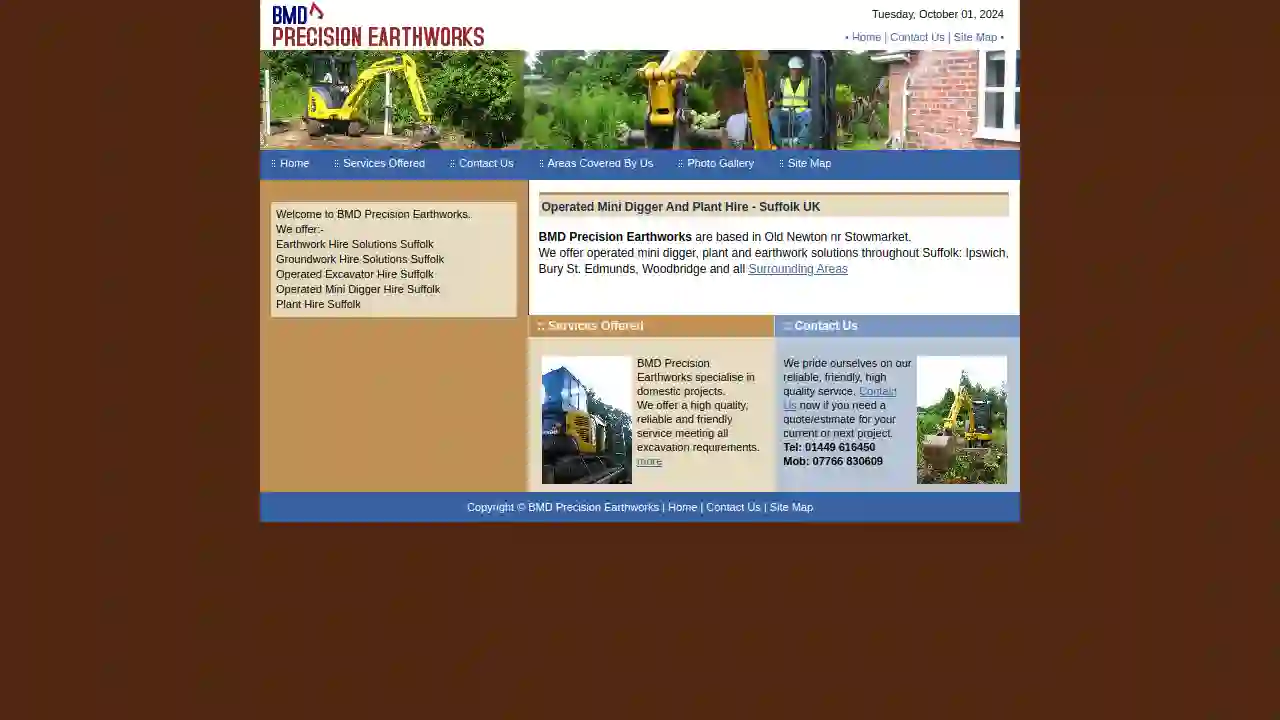
BMD Precision Earthworks
Elmtree House, Silver Street, Elmtree HouseSilver StreetOld NewtonStowmarket, Old Newton, IP14 4HF, GBWelcome to BMD Precision Earthworks BMD Precision Earthworks are based in Old Newton nr Stowmarket. We offer operated mini digger, plant and earthwork solutions throughout Suffolk: Ipswich, Bury St. Edmunds, Woodbridge and all Surrounding Areas. BMD Precision Earthworks specialise in domestic projects. We offer a high quality, reliable and friendly service meeting all excavation requirements. We pride ourselves on our reliable, friendly, high quality service. Contact Us now if you need a quote/estimate for your current or next project.
- Services
- Why Us?
- Gallery
Get Quote
R G Carter
58 reviewsIpswich, GBABOUT US Founded in 1921, R G Carter have been delivering high-quality building, construction and engineering services for public and private clients for over 100 years. We combine a friendly, traditional approach with a passion for quality and innovation. Our values are based upon honesty, trust and the development of long-term relationships. Working nationally and regionally, we provide design, construction and project management services across a variety of sectors; from housing and retail, to commercial and research, and are one of the largest Passivhaus housebuilders in the UK. We are passionate about sustainability and supporting our communities, and continue to work hard to create, revitalise and renew the very best places and spaces for the benefit of the future generations. Together we are building for the future.
- Services
- Why Us?
- Gallery
Get Quote- To
Town Farm LLC
Ipswich, GBWe are a local business dedicated to providing high-quality services to our community. Our team is committed to exceeding your expectations and delivering exceptional results. We are passionate about what we do and strive to build lasting relationships with our clients. Contact us today to learn more about how we can help you achieve your goals.
- Services
- Why Us?
- Gallery
Get Quote 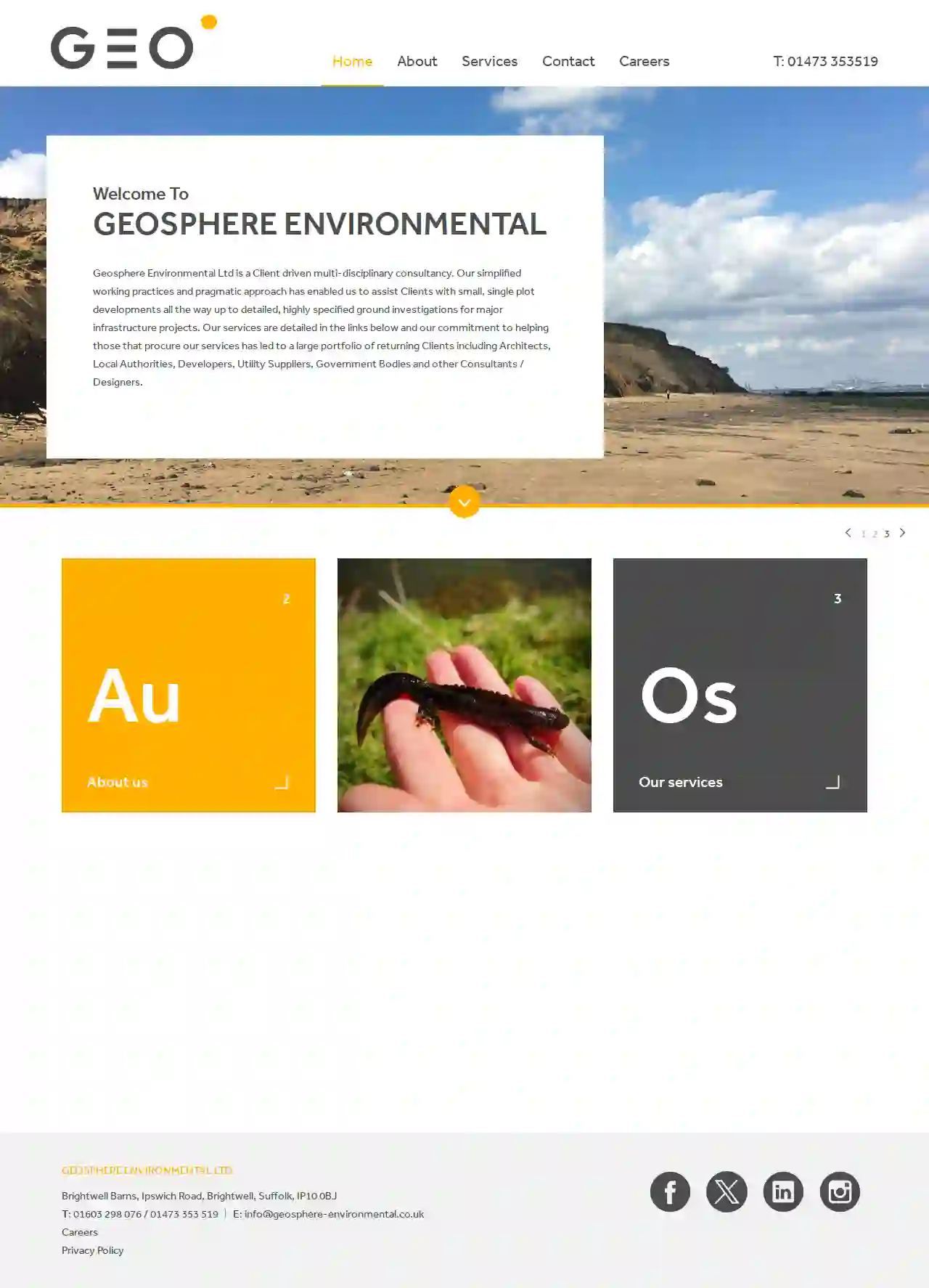
Geosphere Environmental Ltd
55 reviewsBrightwell Barns, Ipswich Road, Brightwell, Suffolk, IP10 0BJ, GBGeosphere Environmental: Your Partner in Environmental Solutions Geosphere Environmental Ltd is a client-focused, multi-disciplinary consultancy dedicated to providing comprehensive environmental solutions. Our simplified approach and commitment to quality have allowed us to assist clients with a wide range of projects, from small, single-plot developments to large-scale infrastructure projects. We offer a comprehensive suite of services, including contaminated land assessment, geotechnical investigations, ecology surveys, tree surveys, and visual inspections. Our team of experienced professionals is committed to delivering high-quality, cost-effective solutions that meet the specific needs of our clients. Since our establishment in 2009, Geosphere Environmental has grown to employ over thirty full-time staff, operating from our main office just outside of Ipswich. Our commitment to simplifying complex situations has earned us a loyal client base, including architects, local authorities, developers, utility suppliers, government bodies, and other consultants and designers. We pride ourselves on our client-centric approach, providing personalized solutions that are free from internal bureaucracy or competition. Our team is dedicated to building long-term relationships with our clients, ensuring their satisfaction and success.
- Services
- Why Us?
- Gallery
Get Quote
Over 13,059+ Excavation Pros on our directory
Our excavation contractors operate in Felixstowe and surroundings!
ExcavationHQ has curated and vetted the Best Excavation Businesses in Felixstowe. Find a trustworthy business today.
Frequently Asked Questions About Excavation Contractors
- Experience: Choose contractors with a proven track record and years of experience in excavation projects similar to yours.
- Licensing and Insurance: Verify that they are properly licensed to operate in your area and carry adequate insurance to protect you from liability in case of accidents or damage.
- Equipment and Resources: Ensure they have the necessary equipment and resources to handle your project efficiently and safely.
- Positive Reviews and References: Check online reviews and testimonials from previous customers. Request references and contact them to inquire about their experience with the contractor.
- Professionalism: Opt for a company that communicates clearly, provides detailed and transparent estimates, and has a responsive and courteous team.
- Clearly Define the Scope: Outline the project's goals, including the excavation area, depth, grade, and intended use.
- Obtain Necessary Permits: Research and acquire any required permits from your local authorities.
- Mark Utility Lines: Contact your utility companies to locate and mark underground utilities to prevent damage.
- Communicate with Neighbors: Inform your neighbors about the project's timeline and potential noise or disruptions.
- Prepare the Site: Clear any obstacles, such as vegetation, furniture, or structures, from the excavation area.
- Discuss Safety Protocols: Review safety procedures with the contractor to ensure a safe work environment.
- Sloped Property: Your property has a significant slope, making it prone to soil erosion or landslides.
- Creating Usable Space: You want to level off a sloped area to create a flat surface for patios, gardens, or other outdoor spaces.
- Preventing Damage: Erosion is threatening existing structures, driveways, or walkways.
- Landscaping Features: You're incorporating tiered gardens, raised beds, or other landscaping elements requiring soil retention.
- Project Size and Scope: Larger, more complex excavations naturally take longer.
- Soil Conditions: Rocky or challenging soil types can slow down progress.
- Site Accessibility: Limited access might require more time for maneuvering equipment and hauling materials.
- Weather: Inclement weather can cause delays.
- Permitting and Inspections: Waiting for permits or inspections can extend the timeline.
How do I find a good excavation contractor?
What should I do before excavation starts?
How do I know if I need a retaining wall?
How long does an excavation project take?
How do I find a good excavation contractor?
- Experience: Choose contractors with a proven track record and years of experience in excavation projects similar to yours.
- Licensing and Insurance: Verify that they are properly licensed to operate in your area and carry adequate insurance to protect you from liability in case of accidents or damage.
- Equipment and Resources: Ensure they have the necessary equipment and resources to handle your project efficiently and safely.
- Positive Reviews and References: Check online reviews and testimonials from previous customers. Request references and contact them to inquire about their experience with the contractor.
- Professionalism: Opt for a company that communicates clearly, provides detailed and transparent estimates, and has a responsive and courteous team.
What should I do before excavation starts?
- Clearly Define the Scope: Outline the project's goals, including the excavation area, depth, grade, and intended use.
- Obtain Necessary Permits: Research and acquire any required permits from your local authorities.
- Mark Utility Lines: Contact your utility companies to locate and mark underground utilities to prevent damage.
- Communicate with Neighbors: Inform your neighbors about the project's timeline and potential noise or disruptions.
- Prepare the Site: Clear any obstacles, such as vegetation, furniture, or structures, from the excavation area.
- Discuss Safety Protocols: Review safety procedures with the contractor to ensure a safe work environment.
How do I know if I need a retaining wall?
- Sloped Property: Your property has a significant slope, making it prone to soil erosion or landslides.
- Creating Usable Space: You want to level off a sloped area to create a flat surface for patios, gardens, or other outdoor spaces.
- Preventing Damage: Erosion is threatening existing structures, driveways, or walkways.
- Landscaping Features: You're incorporating tiered gardens, raised beds, or other landscaping elements requiring soil retention.
How long does an excavation project take?
- Project Size and Scope: Larger, more complex excavations naturally take longer.
- Soil Conditions: Rocky or challenging soil types can slow down progress.
- Site Accessibility: Limited access might require more time for maneuvering equipment and hauling materials.
- Weather: Inclement weather can cause delays.
- Permitting and Inspections: Waiting for permits or inspections can extend the timeline.